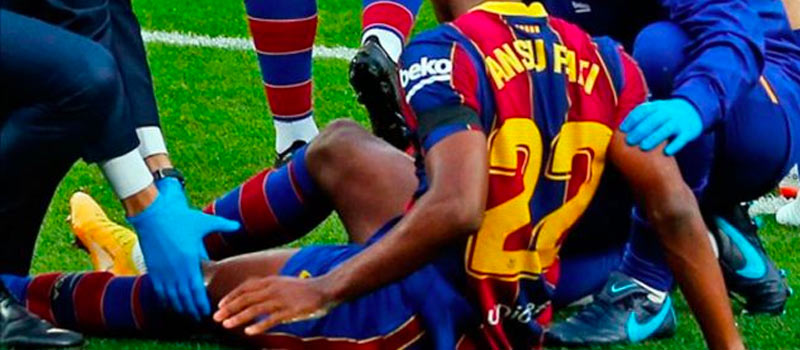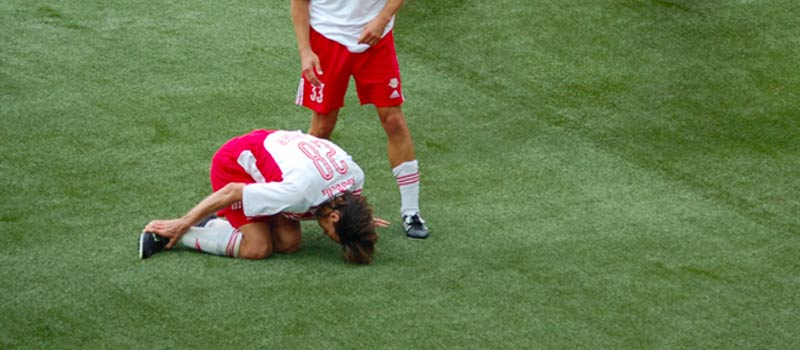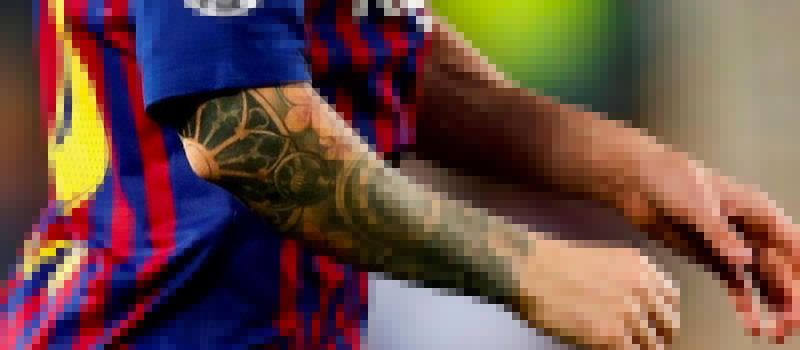-
25 September, 2025
What happened to Gavi’s knee injury and his meniscus tear?

Some time ago, we explained in this blog what Ansu Fati’s meniscus injury meant and how it could evolve. The case of Gavi shows some similarities, although every injury is unique and the outcome is not always the same. In this article, we will review what the meniscus is, what a meniscus tear involves, the main symptoms of a torn meniscus, the different treatment options — from conservative meniscus treatment to arthroscopic meniscus surgery — and the recovery times depending on each case.
-
19 March, 2025
Lateral knee ligament injuries: causes, treatment and recovery

Recently, we learned that Marc Casadó suffered a partial tear of the lateral collateral ligament (LCL) in his knee, yet he was surprisingly able to continue playing until the second half. But is this possible? How do these injuries affect knee stability? What is the difference between treating a medial collateral ligament (MCL) sprain and an LCL strain? What happens with partial LCL injuries? How are they treated? Why do they occur? Are they the same as ACL injuries?
What is the function of the lateral collateral ligament?
The lateral collateral ligament (LCL) plays a crucial role in joint stability. This ligament prevents the knee from “opening” outward (varus instability), meaning it restricts the lateral movement of the tibia relative to the femur. The lateral collateral ligament is the primary external stabilizer of the knee joint. Without it, the knee becomes unstable, making it impossible to perform pivoting sports.
Knee ligaments: key stabilizers
The knee joint relies heavily on its ligaments for stability. The main structures include:
- Medial collateral ligament (MCL): Prevents the knee from collapsing inward.
- Lateral collateral ligament (LCL): Restricts outward movement.
- Anterior cruciate ligament (ACL) and posterior cruciate ligament (PCL): Control front-to-back movement.
The medial collateral ligament (MCL) is the most commonly injured in knee sprains and typically heals well with conservative treatment. In contrast, lateral collateral ligament (LCL) injuries are less frequent but may require surgery if knee stability is compromised.
How are knee ligament injuries treated?
Treatment for knee ligament injuries depends on several factors. Partial ACL injuries can be controversial, with some specialists opting for conservative treatment with rehabilitation, while others prefer early surgical intervention. The main issue with ACL injuries is that they rarely heal on their own, making surgery necessary in most cases. However, medial collateral ligament (MCL) injuries have a high healing rate with conservative management. In the case of lateral collateral ligament (LCL) injuries, like Casadó’s, the situation falls somewhere between these two extremes. Let’s take a closer look…
Treatment for lateral knee ligament injuries
Lateral knee ligament injuries can range from a simple strain to a partial tear or a complete rupture. Treatment varies based on severity:
- Medial collateral ligament (MCL) sprain: Usually treated with partial immobilization, physical therapy, and muscle strengthening.
- Lateral collateral ligament (LCL) sprain: May require closer monitoring, as persistent instability could necessitate surgery.
- Lateral ligament strain: Rest, anti-inflammatory medications, and progressive strengthening are recommended.
How long does it take to recover from an LCL sprain?
The recovery time for an LCL sprain depends on the severity of the injury:
- Mild: 2 to 4 weeks with rest and physical therapy.
- Moderate: 4 to 8 weeks with conservative treatment.
- Severe (partial or complete tear): May require surgery, with recovery lasting 3 to 6 months.
How to know if you need knee surgery?
In cases like Marc Casadó, to determine if knee ligament surgery is necessary, key factors include:
- The percentage of ligament damage.
- Imaging tests such as MRI scans.
- Clinical examination and knee stability.
- The patient’s level of physical activity.
If the knee is unstable or the athlete has high physical demands, surgery may be the best option to prevent recurrent injuries and further damage to structures like the meniscus or knee cartilage.

“For lateral knee ligament injuries, if the joint is unstable or the athlete has high physical demands, surgery may be the best option to prevent relapses and damage to other structures like the meniscus or cartilage.”
If you have pain on the outer side of your knee, consult a specialist
If you experience pain in the lateral collateral ligament or have suffered an MCL sprain, consult a specialist to determine the best treatment. A proper diagnosis can make the difference between a quick recovery and a chronic injury. Listen to your body and take action in time!
HAVE YOU SUFFERED A LATERAL KNEE LIGAMENT INJURY OR EXPERIENCE INSTABILITY AND PAIN? WANT TO CONTACT DR. SERGI SASTRE?
-
1 April, 2022
Osteochondral graft or transplant, a substitute technique for cartilage injuries
Articular cartilage is a unique tissue. Its matrix allows movement between the joint surfaces with the least possible friction and supports countless cycles throughout the person’s life. An injury to this structure, which does not affect the integrity of the subchondral bone, will not repair itself spontaneously and, as it is asymptomatic, can lead to progressive degeneration of the joint up to severe osteoarthritis, whose only possibility of treatment would be a replacement by a mechanical prosthesis. There are three treatment techniques for hilar cartilage injuries: palliative, reparative and substitutive, also known as osteochondral graft or transplant, which we will talk about today. Let’s see…
-
27 May, 2021
Patellar tendinitis: What it is, symptoms, causes, evolution and treatment

The patellar tendon attaches to the bottom of the patella and the tibia (Anterior tibial tuberosity). It is one of the largest and most powerful tendons in the body, as it has to propel us to overcome gravity in activities such as walking, running, and jumping. Patellar tendinopathy or tendinitis is also known as “jumper’s knee”, since it is more common in athletes whose sports include frequent jumping, such as basketball, volleyball, athletics, … However, if you are a person who does not practice jump sports but feels pain in the kneecap, you may also suffer from patellar tendinitis from what we call repetitive microtrauma.
-
9 November, 2020
Ansu Fati’s meniscus injury: What happened and what are the treatment options?

The meniscus is a structure of elastic consistency that is located between the femur and the tibia and that acts as a shock absorber. It is specially shaped like a crescent so that the femur fits perfectly with the tibia. We have 2 menisci in each knee, one external and one internal. The most common cause of meniscus injury is a knee twist, as happened on this occasion. Ansu Fati’s meniscus injury occurred when, his foot was on the ground and due to contact with the opponent, the knee turned in an unnatural way, causing the consequent meniscus injury. It is for this reason that footballers, who anticipate a contact, try to lift their feet off the ground. By doing so, they avoid this type of injury or even more serious ones associated with other structures of the knee. As such, a meniscus injury can be associated with a tear of ligaments (anterior cruciate, internal lateral) and / or the articular cartilage. Read more…
-
3 December, 2019
Shoulder dislocation: What is it and when should it be operated?

The pilot Marc Márquez recently had to be operated for his recurrent shoulder subluxation. Shoulder dislocation or a dislocated shoulder is what is generally referred to as “the shoulder popped out of its place”. This injury must be treated with caution, and if it becomes recurrent it must be repaired through arthroscopic surgery . Let’s see what this injury consists of, when it is considered recurrent and when it is necessary to operate.
Read more… -
4 October, 2019
A sprained ankle: what is it and why does it sometimes take a long time to heal or end up requiring surgery?

In professional sport, we see athletes who sprain their ankle and who are up and playing without and problem just a few weeks later. On the other hand, we also see athletes who have to undergo surgery to fix their sprained ankle and are inactive for months. We will look at what a sprain is, why it sometimes takes a long time to heal, why ankle pain persists, what causes the dreaded “poorly healed sprained ankle” and why an operation may be necessary…
-
23 October, 2018
Messi’s elbow injury: what it could be and why he is not being operated on

In light of Lionel Messi’s elbow injury last weekend, a lot of people are asking me about it. According to the official report from the FC. Barcelona Medical Department: “Tests carried out on the first-team player, Leo Messi, have confirmed that he has a fracture of the radius bone in his right arm. He will be out of action for approximately three weeks”. Without being in possession of all the information on the case, I will try to explain what Messi’s elbow injury consists of, and in which cases surgery may not be necessary.
-
12 June, 2018
Choice of treatment for rotator cuff injury

We have talked several times before about rotator cuff injury. We have explained its characteristics and treatment, the injury stages, symptoms, causes and risk factors. In today’s post we will explain the factors that influence treatment choice. Without treatment, rotator cuff injury can lead to permanent stiffness or weakness and progressive degeneration of the shoulder joint. It can even mean not being able to lift the arm in the most advanced stages.










